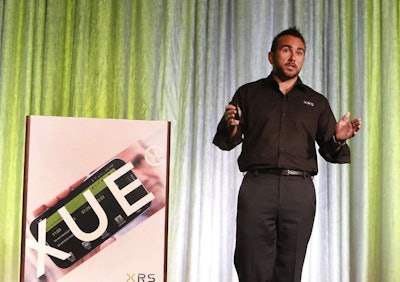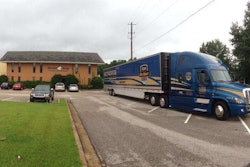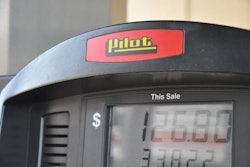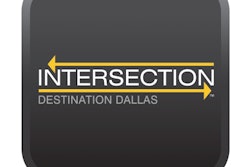 Jay Coughlan gives the opening address at XRS’ user conference
Jay Coughlan gives the opening address at XRS’ user conferenceJay Coughlan has been hunting elk in Montana for several consecutive years. Before the opening day of last year’s hunt he spent two days in the wilderness spotting bulls. Before the second day came to a close he settled in for one last view.
About 300 yards away he saw a bear trudging through an open, rocky area. He had seen bears before but few, if any, compared to this one in stature. He watched carefully through his scope until the animal disappeared into the woods 80 yards away.
For the next 15 minutes he lost track of its whereabouts. Knowing he was within the bear’s range of smell he began “seeing a lot better” in the woods as he plotted an escape.
“I just had a paradigm shift,” joked Coughlan, chairman and chief executive officer of XRS Corp., during the company’s user conference in Minneapolis, Minn., on August 19.
The paradigm shift, he explained, was symbolic of another destructive force that prompted him and other leaders of XRS Corp. to change the business model. The change, which began in 2011, not only helped to avert a potential disaster but has created a competitive advantage in the market for trucking technology, he said.
The transition
Coughlan began his career in technology by selling mainframe systems. A number of very successful companies have fallen victim to the forces of “discontinuous innovation” in the past 30 years. In the 1970s and 80s, for example, the mini-computer replaced the mainframe and companies like Data General and Prime suddenly became multi-billion dollar organizations.
In the late 1980s and 1990s, personal computers from Dell, Compaq and HP supplanted the mini-computer, but these too are now “done or on a respirator,” he said. Next came corporate devices and applications from Palm, Nokia and Blackberry. Then, four years ago, a new market leader emerged in Apple with the iPhone and iPad.
Since 2011, XRS Corp. has changed its business model from being a supplier of in-cab computing and software platforms for commercial and private fleets to a provider of “trucking intelligence.”
Refocusing its business model, products and strategy to this end has been painful both culturally and fiscally. XRS had to replace 75 percent of its employees. It also dropped a hefty revenue line in hardware sales.
“When I showed up at Xata seven years ago we were 85 percent hardware revenue. We’ve switched now. It’s less than 15 percent. That’s a revenue line that has dropped suddenly like a rock,” he said during an interview with CCJ.
During the user conference, Coughlan predicted that competitors of XRS who have not made a similar change in strategy may not survive, at least not in present form. Naturally, any company would be reluctant to give up a revenue line and their investors would not have patience to see such a strategy through to completion. As a publicly traded company, Coughlan has had to convince a lot of skeptics.
“At every board meeting I had to remind (our investors) that we are on a journey,” he said.
It helped that the company’s third largest investor, John Deere, has seen its own competitive landscape change dramatically. It is not enough to be one of the market leaders in tractors and farm equipment. It now provides intelligence and big data to farmers. John Deere uses equipment sensors to help farmers manage their fleet. And the sensory data is combined with historical and real-time data sets to predict weather, soil conditions, crop features and other information to create competitive advantage.
As part of making the change, XRS Corp. wrote a new mobile application from the ground up. This alone took more than two years to complete. The release of the XRS mobile app earlier this year has spurred a rapid increase in revenue. Its third quarter fiscal results, ending June 30, 2013, showed a growth in revenue by 21 percent, year over year.
Combining its experience in trucking with its speed in mobile app development, Coughlan said, gives XRS Corp. an advantage in the marketplace, particularly with regards to meeting the government’s mandate for the use of electronic logs. All drivers will need to be using electronic logging devices by January, 2017.
With the release of its new XRS application, and with other developments, the company is positioned in what research firm Gartner calls the “Nexus of Forces” for convergence in technology. These converging forces are mobile, social, information and cloud computing.
Mobile
Workers expect their user experience with technology at work to be the same as their user experience with their own, personal devices. Wireless networks are also changing rapidly from 3G to 4G and beyond. XRS is an “all-mobile” fleet management application that is compatible with more than 50 smartphone and tablet devices.
“We want to be able to offer the right device and not be limited by having our own modem in technology,” he said.
Information
To be a market leader in information requires application development and big data, which is the ability to glean insights from massive amounts of data. With the explosive growth of smart phones and tablets, more data has been created in the last four years than all previous years combined, he said. Data collected via the XRS application is used by fleets to make decisions on how to improve operations and ensure compliance.
Cloud
XRS Corp. uses a public cloud architecture from Amazon which allows it to have data, security and redundancy at a very high level.
Social
XRS has developed the largest social site on the web for trucking called X Nation that allows drivers to share life on the road and move between work and personal life. Social is also a critical part of its strategy for product support. Fleet managers and other users, including drivers, can answer product-related questions.
 Christian Schenk shares insights on mobile technology
Christian Schenk shares insights on mobile technologyAs with any new software product, XRS has some minor glitches that customers discussed during a session at the user conference led by Christian Schenk, senior vice president of product strategy and market growth. He conceded as much by saying that “this is a new product so it’s going to hurt a little as we get through it.”
Overall, fleets and their drivers seemed most impressed by the fast implementation time for electronic logs, electronic inspections and other features of the application.
“I had 10 minutes of instruction and I was on my way,” said Jeff Feifel, a driver for Allied Automotive Group, one of North America’s largest vehicle transporters and one of the first fleets using XRS.
Allied is implementing the platform on 7-inch Samsung Galaxy 2 tablets connected to a 4G LTE wireless network. The devices are part of the Samsung Safe group, a family of enterprise-grade devices that include security and feature enhancements for business use. XRS announced a new partnership with Samsung at the conference.
“It is allowing us to create a virtual terminal,” said Mark Gendregske, chief executive of Allied. “It has turned out to be a fantastic platform.”
Drivers and mechanics at the company are ahead of management in driving the adoption of XRS, which is unusual in the fact that technology is often driven from the top down.
“The number one challenge is to catch up to the drivers. They have taken it and sprinted with it,” he added. Allied has over 40 apps scheduled as part of the rollout of XRS, many of which are personal apps for drivers.
“It makes for a happier employee,” he said. “They are more focused when they are on duty for executing world class service in the safest manner possible.”











